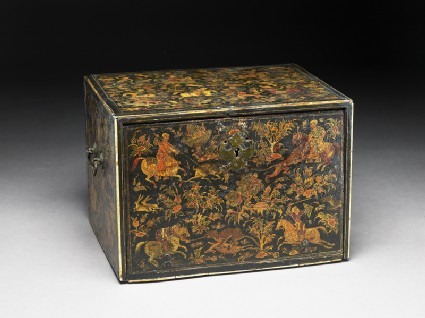Browse: 34 objects
- Reference URL
Actions
Writing cabinet decorated with hunting scenes
-
Description
Lacquer painting was an important luxury art in Safavid and Qajar Persia and Mughal India. As with many of the Mughal decorative arts, very few early examples now survive. This painted and lacquered scrutore, or small portable writing cabinet, is one of only two known examples of its type.
The four sides of the cabinet are decorated with spirited scenes of noblemen in Mughal dress on caparisoned horses, hunting various wild beasts, including deer, lion, tiger, fox and crane. The figures are finely painted in a restricted earthly palette, generously heightened with gold, which is also used profusely on the surrounding large and exuberantly burgeoning shrubs and trees, creating dramatic contrasts with the black background. The top has been restored and weakly repainted in a more Persianate style, probably in the 19th century.
Drop-front caskets of this kind probably first appeared in Germany after the middle of the 16th century and soon became popular in Italy, the Iberian peninsula and elsewhere. The commonest Indian type of scrutore is teak-veneered with ivory inlay; examples in other techniques are much rarer.
-
Details
- Associated place
-
Asia › Pakistan › Sindh province (possible place of creation)
- Date
- early 17th century
- Material and technique
- wood, painted and lacquered
- Dimensions
- 20 x 28.5 x 21.5 cm (height x width x depth)
- Material index
- Technique index
- Object type index
- No. of items
- 1
- Credit line
- Purchased, 1977.
- Accession no.
- EA1978.129
-
Further reading
Harle, J. C., and Andrew Topsfield, Indian Art in the Ashmolean Museum (Oxford: Ashmolean Museum, 1987), no. 99 on pp. 88-89, pl. 23 (colour) & p. 89
Michell, George, and Mark Zebrowski, Architecture and Art of the Deccan Sultanates, New Cambridge History of India, 1: The Mughals and their Contemporaries, 7 (Cambridge: Cambridge University Press, 1999), pp. 147-148, fig. 109
Digby, S., ‘The Mother-of-Pearl Overlaid Furniture of Gujarat: The Holdings of the Victoria & Albert Museum’, R. Skelton et al., Facets of Indian Art: A Symposium held at the Victoria and Albert Museum (London: Victoria and Albert Museum, 1986), p. 215, fig. 11
Zebrowski, M., ‘Indian Lacquerwork and the Antecedents of the Qajar Style’, William Watson, ed., Lacquerwork in Asia and Beyond: A Colloquy Held 22-24 June 1981, Colloquies on Art & Archaeology in Asia, 11 (London: University of London, Percival David Foundation of Chinese Art, 1982), cat. pp. 334-335, pl. 1
London: Victoria and Albert Museum, 21 April-22 August 1982, The Indian Heritage: Court Life and Arts under Mughal Rule, Robert Skelton, ed. (London: Victoria and Albert Museum, 1982), no. 544 on. p. 161, illus. p. 161 fig. 544
Location
Objects are sometimes moved to a different location. Our object location data is usually updated on a monthly basis. Contact the Jameel Study Centre if you are planning to visit the museum to see a particular object on display, or would like to arrange an appointment to see an object in our reserve collections.
Galleries
Publications online
-

Indian Art in the Ashmolean Museum
Lacquer painting was an important luxury art in Safavid and Qajar Persia and Mughal India, being used especially for fine-book-bindings made for royal patrons. As with many of the Mughal decorative arts, very few early examples now survive. This painted and lacquered scrutore, or small portable writing cabinet, is one of only two known examples of its type.
Drop-front caskets of this kind probably first appeared in Germany after the middle of the 16th century and soon became popular in Italy, the Iberian peninsula and elsewhere. Before 1600 examples were being made in Japan and India after models supplied by the Portuguese. The commonest Indian type of scrutore is teak-veneered with ivory inlay; examples in other techniques are much rarer.
The four sides of the cabinet are decorated with spirited scenes of noblemen in Mughal dress on caparisoned horses, hunting various wild beasts, including deer, lion, tiger, fox and crane. The figures are finely painted in a restricted earthly palette, generously heightened with gold, which is also used profusely on the surrounding large and exuberantly burgeoning shrubs and trees, creating dramatic contrasts with the black background. The top has been restored and weakly repainted in a more Persianate style, probably in the 19th century.
The cabinet has been attributed by two authorities to the Deccan on stylistic grounds, but more recently it has been assigned to the Western province of Sind, which was a major centre for the manufacture of cabinets as well as painted and lacquered bows in the early 17th century.
© 2013 University of Oxford - Ashmolean Museum











